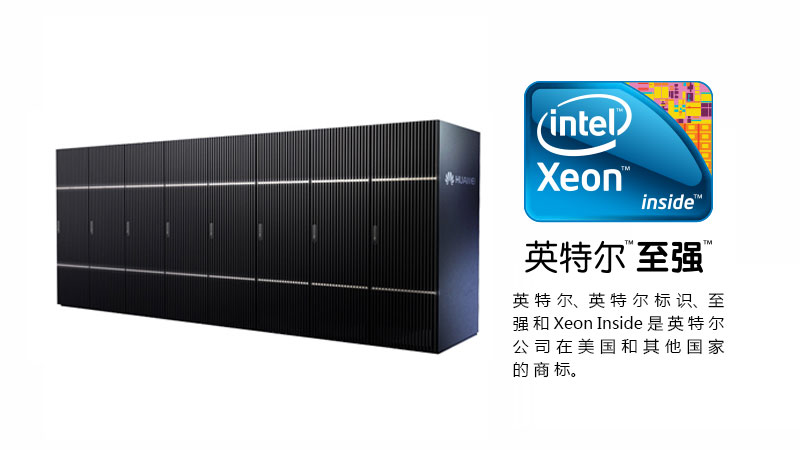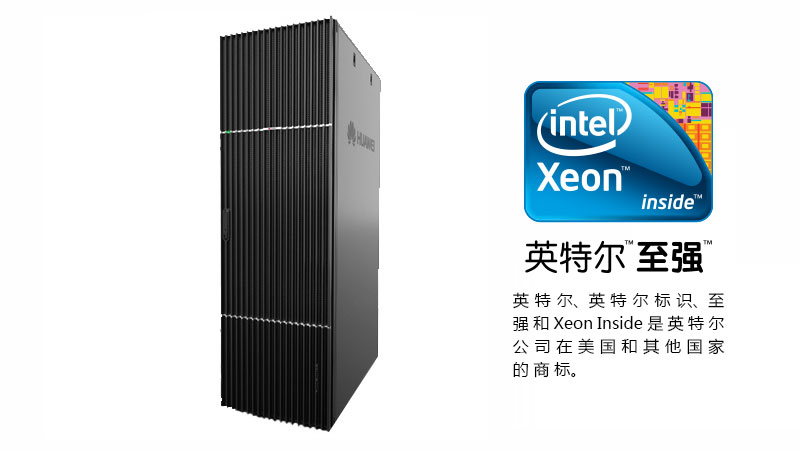Sistema de almacenamiento empresarial OceanStor de la serie 18000
El Sistema de Almacenamiento Empresarial de la serie OceanStor 18000 de Huawei (en adelante, la serie OceanStor 18000) es una plataforma de almacenamiento óptima para los centros de datos de próxima generación que presentan virtualización, nube híbrida, IT simplificada y baja huella de carbono. La serie OceanStor 18000 cumple con los requerimientos comerciales principales exigidos por la industria, incluidos el sector financiero, gubernamental, energético, de fabricación, transporte, educación y telecomunicaciones.
The OceanStor 18000 series is Huawei's high-end flagship product series. This series consists of two models, OceanStor 18500 and OceanStor 18800, which provide TRUSTED and FLEXIBLE storage solution for critical appliances of enterprise data centers.
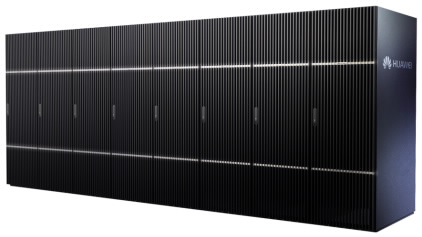
The OceanStor 18000 series is developed on the Smart Matrix architecture and runs the fully virtualized XVE operating system. With such a competent design, the OceanStor 18000 series can scale out to 16 controllers, 3216 disks (SSD/SAS/NL-SAS), 7168 TB capacity, 192 GB bandwidth, 3 TB cache, and 192 host ports (Fibre Channel/FCoE/iSCSI). It allows the concurrent access from a maximum of 65,536 servers.
Besides the powerful hardware configurations, the OceanStor 18000 series further strengthens its competitiveness by employing the Smart series resource management software and the Hyper series data protection software. These software suites boost system resource utilization, intelligently prioritize mission-critical services, and ensure a 24/7 service availability.
The OceanStor 18000 series is delivered as a turnkey solution, and its cabinets can be separately deployed based on customers' requirements.
HUAWEI OceanStor 18000 series is designed for mission-critical appliances of enterprise customers. It provides trusted and flexible storage solution for enterprise-level data centers (DCs). Its highlights include the enterprise storage–dedicated XVE operating system, Smart Matrix architecture, fully virtualized intelligent volumes, Smart series resource management software, Hyper series data protection software, and Ultra series advanced software. With all these innovative features, the OceanStor 18000 series offers unprecedented advantages in performance, availability, scalability, and cost.
TRUSTED, Ensuring 24/7 Availability for Core Services
- Fully redundant system design: The Smart Matrix architecture with a maximum of 16 redundant controllers boosts system performance, protects system reliability, and ensures zero data loss.
- RAID 2.0 technology accelerates data recovery by 20 times.
- Intelligent protection dedicated to core services: The SmartQoS and cache partitions provide advanced protection for core services.
- Complete disaster recovery solution: The system recovery point objective (RPO) is reduced to 0~5 seconds, ensuring the lowest data loss amount in the industry. The Hyper series disaster recovery (DR) management software ensures the hitless system operating.
FLEXIBLE, Meeting Future Challenges
- Incomparable performance and specifications: The OceanStor 18000 series can scale up to 3,216 disks to provide an industry-leading capacity up to 7,168 TB. It also provides 192 GB system bandwidth, 3,072 GB cache, 1,000,000 IOPS, and concurrent accessibility from 65,536 servers. With such a powerful configuration, the OceanStor 18000 series meets demanding storage requirements of environments with diversified applications and heavy service loads.
- All-dimension scalability: The 4S scalability dynamically improves system performance and capacity to meet the increasing services.
- Smart series software: achieves the intelligent data storage.
- Easy adaptation to virtualization trends: The fully virtualized software architecture with wide support for open standards improves the working efficiency, data protection, and management capability in virtual environments.
1. Smart Matrix architecture
The Smart Matrix architecture is a Huawei-proprietary system architecture for enterprise-level storage systems. By controller scale-out, this architecture shatters the physical restrictions of the previous architectures and improves the system scalability and availability to the highest level.
PCI-e full-switch network for an E2E reliability: The Smart Matrix architecture is based on the PCI-e 2.0 network that interconnects all OceanStor 18000 series controllers to exchange information. The system bandwidth reaches up to 192 GB/s. Each controller incorporates the functionality of front end, cache, and back end. Multiple controllers can send I/O requests to disks simultaneously, so the disk I/O efficiency is greatly enhanced.
Scale-out capability for 99.999% availability: The Smart Matrix architecture allows the linear expansion of system resources and online adding of a maximum of 16 controllers. The controllers can be deployed anywhere in a DC based on site requirements.

2. Fully virtualized smart volumes
In the OceanStor 18000 Series, disks are divided into chunks that have a granularity exact to megabyte. Therefore, data can be evenly stored on more disks and all those disks can participate in reconstruction if any one disk fails. In this way, the reconstruction efficiency is improved and reconstruction period is shortened, and the chances of a second disk failure during reconstruction are reduced. This data storage mechanism lays a foundation for the Smart series functions and improves system reliability.
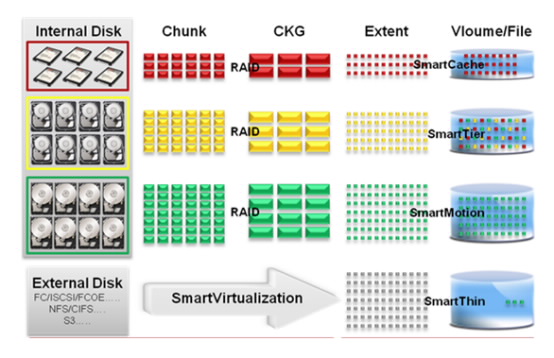
3. Smart series resource management software
The Smart series software improves the OceanStor 18000 series efficiency and flexibility.
SmartTier
The SmartTier automatically analyzes data access frequency in a finer data size and migrates data to a proper disk tier such as SSD, SAS, or NL-SAS. Based on application characteristics, customers can specify the data size (256 KB to 64 MB) for migration, statistical period (by hour or by day), migration mode (automatic or manual), migration period, and migration speed. The SmartTier improves the storage performance of hot data, reduces the storage cost of cold data, and increases the overall system price performance ratio.
SmartMotion
The SmartMotion automatically balances data distribution within the same disk tier to avoid system bottlenecks caused by hotspot disks, improving disk utilization and the overall disk reliability.
SmartQoS
The SmartQoS classifies I/Os into priority-specific queues according to application priorities. Sufficient storage resources are reserved for I/O queues with high priorities to meet their performance requirements, while a resource upper threshold is set for I/O queues with low priorities to avoid their overuse of resources. The execution period of the SmartQoS strategy is customizable.
SmartPartition
The SmartPartition allocates different memory capacities based on capacity requirements of applications to ensure that sufficient cache resources are reserved for mission-critical applications.
SmartThin
The SmartThin uses the 64 KB data size in allocating system storage space on demand and recycles deleted space for typical applications such as VMware, Veritas Storage Foundation, and Windows Server. It also pre-allocates space to thin LUNs, supports conversion and data replication between thin LUNs and thick LUNs.
SmartVirtualization
The SmartVirtualization simplifies the storage system management, improves the resource usage, and maximizes customers' return on invest (ROI) by integrating the resources on heterogeneous storage arrays and providing unified storage to application servers.
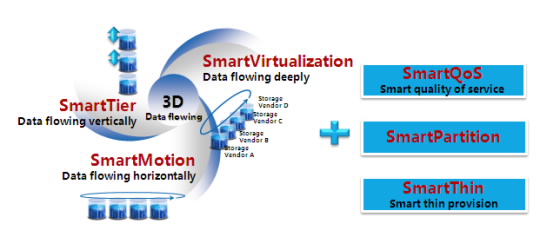
4. Hyper series data protection software
HyperSnap
The HyperSnap generates snapshots for online data at specified points in time without interrupting system services. Those snapshots can be used for backup, R&D, data mining, and data recovery when the original data is lost by accident. Volumes can be snapshot within several seconds regardless of their storage capacities. If you want to limit the storage space occupied by snapshots, you can use the incremental snapshot that only saves the changed data between two snapshot points in time.
HyperClone
The HyperClone generates complete physical copies (mirror data) for data on original LUNs. You can synchronize and split a primary/secondary LUN pair to obtain the physical copies. Each primary LUN can have a maximum of eight physical copies that can be separately used for different data analysis purposes.
HyperReplication /S
The HyperReplication /S mirrors data from a primary LUN to a secondary LUN on a different storage array. It is applicable to intra-city data protection and achieves zero data loss.
HyperReplication /A
The HyperReplication /A replicates data from a primary LUN to a secondary LUN in a remote location that may be thousands of kilometers away. The minimum recovery time objective (RTO) is 5 seconds, minimizing data loss during system downtime. The data replication period can also be customized to off-peak hours to minimize the adverse impact on application and host performance.
HyperReplication /CG
The HyperReplication /CG creates a consistency group comprised of multiple data volumes that have share the same replication policy. The consistency group ensures data consistency among the member data volumes.
5. 99.9999% reliability
The OceanStor 18000 series meets customers' requirement for service availability from all aspects including architecture, module, component, data, software, and solution.
The OceanStor 18000 series is equipped with a maximum of 16 redundant controllers that are interconnected through a PCI-e 2.0 network and connected to two redundant data switches for reliable data transmission over a long distance.
The RAID 2.0 chunk-based volume virtualization mechanism shortens the reconstruction period of 1 TB data to 30 minutes and lowers the dual-disk failure rate.
All internal system channels such as host I/O channels, disk I/O channels, PCI-e switching channels, GE switching channels, and LAN channels have redundant paths. Those channels are separated to ensure the separation of service, control, and management planes for independent fault diagnosis and rectification.
The OceanStor 18000 series power supply and heat dissipation modules are also redundant. The failure of any module does not affect the stable operating of the overall system.
The Hyper series and Ultra series data security software together with the redundancy design safeguard customers' data locally and remotely. The Hyper series and Ultra series software plays an important role in Huawei's DR solutions for strengthening the service availablity.
6. Unprecedented scalability
Based on the Smart Matrix architecture, the OceanStor 18000 series can scale up to 3,216 disks and supports a maximum of 7.2 PB available capacity, 3 TB memory, and 192 Fibre Channel or iSCSI ports.
The OceanStor 18000 series is also a distributed multi-controller storage system whose controllers can be expanded from 2 to 16 without interrupting services. It has up to eight system bays and two expansion disk bays and each system bay houses controllers. An OceanStor 18000 series bay can house a maximum of 192 3.5-inch disks or 408 2.5-inch disks and a disk bay can house a maximum of 192 3.5-inch disks.
The OceanStor 18000 series offers disks ranging from speedy enterprise-level SSDs to 2 TB NL-SAS disks. Enterprise-level SSDs carry higher workloads with less power. The storage tiering technology optimizes system performance and brings down the costs by using different types of disks. The OceanStor 18000 series also offers 8 Gbit/s Fibre Channel ports and 10 Gbit/s Ethernet ports used for FCoE and iSCSI connections.

Based on deep understandings of customer requirements, Huawei delivers typical solutions tailored to meet the storage requirements for mission-critical services, virtual environment, diversified and heavy workload appliances and disaster recovery (DR) solution.
Primary Storage for Mission-Critical Services
Typical services
Telecom BOSS systems, banking and securities transaction systems, hospital information system (HIS), e-Government, and social security systems
Application scenario
High data availability: a server cluster comprising two or more servers is required for offering 24/7 services free from single points of failure
High performance storage is required to ensure quick responses to mission-critical services, which are under heavy stress.
Benefits
High availability: provides multi-controller Smart Matrix architecture to ensure full redundancy, XVE-based virtualization supporting many-to-many rapid disk reconstruction, synchronous remote data replication with zero data loss, and UltraAPM and UltraVR for DR and failover of applications in physical and virtual environments
High performance: provides a maximum of 16,000,000 IOPS to sustain heavy-loaded services and on-demand online performance expansion.
Mission-critical services intelligently prioritized: provides SmartTier, SmartQoS, and SmartPartition capabilities to enable service level agreements (SLAs) for mission-critical services.
Tiered data storage and protection: implements local protection for non-critical data and remote protection for mission-critical data.
Network topology
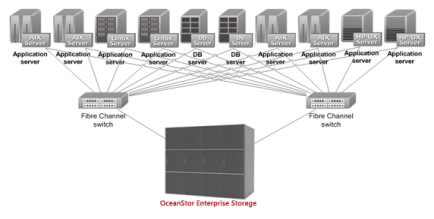
Storage for Virtual Environments
Typical services
Call center agent systems, individual desktops, and software development and test environments
Application scenario
VMs where a large number of non-critical applications and individual desktops are deployed require storage that can:
- Provide large capacity, high performance, and flexible scalability
- Allow quick VM deployment
- Improve VM storage resilience
- Optimize performance automatically
- Ensure end-to-end storage management
Benefits
High performance and massive storage capacity: With its scale-out architecture, the OceanStor 18000 series provides a maximum of 16 controllers, 3,216 disks, and 16,000,000 IOPS. The on-demand performance and capacity provisioning fulfils meet large-scale service environments.
Simplified VM deployment, efficient I/O processing, and optimal resource allocation: The HyperSnap and HyperThin capabilities make it easier and quicker to deploy VMs. Chunk-level virtualization, SmartMotion, and SmartTier enable the OceanStor 18000 series to process I/O efficiently under a multi-VM environment. SmartPartition and SmartQoS ensure optimal resources allocation to mission-critical VMs. In addition, by supporting vStorage APIs for Array Integration (VAAI), session resource management (SRM), and vStorage APIs for Storage Awareness (VASA), the OceanStor 18000 series improves production efficiency and data protection in virtualized environments.
Network topology
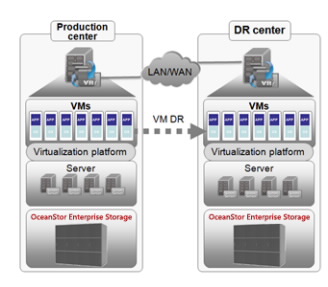
Large-scale Storage for Mixed Loads
Typical services
Centralized data center storage
Application scenario
Storage for mixed loads such as the unified storage for critical and non-critical services that have no obvious I/O characteristics
Storage that balances capacity, performance, and costs
Storage that provides multiple interfaces and protocols for a scenario that has diversified hosts and applications
Benefits
Automatic balance between performance and capacity: SmartMotion optimally balances performance and capacity.
Tiered storage: SmartTier improves storage performance and reduces costs by storing data of different access frequencies to a proper storage tier such as SSD, SAS, or NL-SAS.
Multiple interfaces and protocols: The OceanStor 18000 series supports various protocols such as Fibre Channel, iSCSI, FCoE, VAAI, VASA, and SRA, providing multiple host ports and ensuring compatibility with virtualization applications.
Network topology
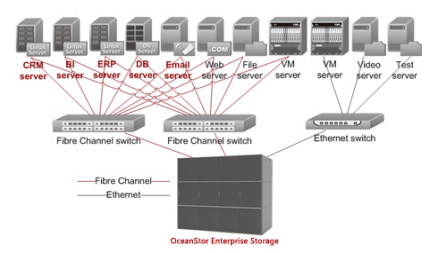
DR Solution
Typical services
Telecom BOSS systems, banking and securities transaction systems, and mission-critical systems for finance and social security
Application scenario
Data stored only in one place may be lost and cannot be retrieved in the event of a regional natural disaster, such as an earthquake, a flood, or a fire. Therefore, intra-city and remote DR centers are required for recovering data quickly and minimizing the loss after natural disasters.
Benefits
Efficient data replication: HyperReplication is used to back up data to intra-city and remote data centers and supports quick data recovery and synchronous/asynchronous data replication.
Minimized RPO: Memory time stamps are used to shorten asynchronous replication intervals, reducing the asynchronous replication RPO to 5 seconds.
Simplified DR management: UltraAPM and UltraVR provide intuitive and well-organized DR management processes, making it easier to manage the DR systems.
Network topology


